Focaccia
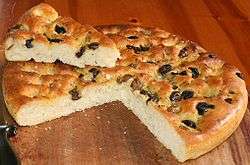 Homemade focaccia with olives and herbs | |
| Type | Flatbread |
|---|---|
| Place of origin | Italy |
| Main ingredients | High-gluten flour, oil, water, salt, yeast |
|
| |
Focaccia (Italian pronunciation: [foˈkat͡ʃːa]) is a flat oven-baked Italian bread product[1] similar in style and texture to pizza doughs. It may be topped with herbs or other ingredients. Focaccia is popular in Italy and is usually seasoned with olive oil, salt, sometimes herbs, and may at times be topped with onion, cheese and meat. It might also be flavored with a number of vegetables. Focaccia can be used as a side to many meals, as a base for pizza, or as sandwich bread. Focaccia al rosmarino (focaccia with rosemary) is a common focaccia style in Italian cuisine that may be served as an antipasto, appetizer, table bread, or snack.
Composition
| Part of a series on |
| Pizza |
|---|
.jpg) |
|
Pizza varieties
|
|
Cooking variations |
|
Pizza tools |
|
Related articles |
The common-known focaccia is salt focaccia. Focaccia doughs are similar in style and texture to pizza doughs, consisting of high-gluten flour, oil, water, salt and yeast. It is typically rolled out or pressed by hand into a thick layer of dough and then baked in a stone-bottom or hearth oven. Bakers often puncture the bread with a knife to relieve bubbling on the surface of the bread.
Also common is the practice of dotting the bread. This creates multiple wells in the bread by using a finger or the handle of a utensil to poke the unbaked dough. As a way to preserve moisture in the bread, olive oil is then spread over the dough, by hand or with a pastry brush prior to rising and baking. In the northern part of Italy, lard will sometimes be added to the dough, giving the focaccia a softer, slightly flakier texture. Focaccia recipes are widely available, and with the popularity of bread machines, many cookbooks now provide versions of dough recipes that do not require hand kneading.
Comparison with pizza
The primary difference between conventional pizza (round, Neapolitan pizza) and focaccia is that pizza dough uses very little leavening (baker’s yeast), resulting in a very thin, flat and flexible crust, while focaccia dough uses more leavening, causing the dough to rise significantly higher. The added leavening firms the crust and gives focaccia the capacity to absorb large amounts of olive oil. Unleavened pizza dough is already too dense to absorb much olive oil. A conventional loaf of bread is too tall to absorb olive oil all the way through to its center. Being shorter in height than a conventional loaf and less dense than a pizza dough, focaccia can indeed absorb olive oil all the way to its center or at least nearly so. As such, focaccia might well be thought of as "olive oil bread".
Focaccia is most often square whereas conventional pizza is more commonly round. Focaccia most often employs more salt than pizza.
There exist traditional Italian pizza recipes, incorporating more leavening, in amounts similar to focaccia, especially in southern Italy, and specifically sfinciuni (Sicilian pizza). If these leavened pizzas were to incorporate equivalent amounts of olive oil in the dough, they would be very similar to a focaccia, except perhaps for the herbs or toppings used. Similarly any "thick-crust" pizza that incorporates large amounts of olive oil would be very similar to focaccia, again except for the variance in the herbs and toppings employed.
Contrary to pizza where more than one topping is often found mixed on the same pizza, toppings are not commonly mixed on one focaccia although one topping and one herb might be mixed. Whereas pizza often has toppings peppered only intermittently on its surface, on focaccia, a single topping is often layered more uniformly and thick.
Etymology and regional variants
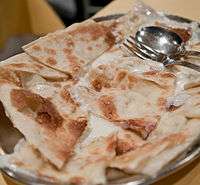
In Ancient Rome, panis focacius[1] was a flat bread baked on the hearth.[2] The word is derived from the Latin focus meaning "hearth, place for baking."[3] The basic recipe is thought by some to have originated with the Etruscans or ancient Greeks, but today it is widely associated with Ligurian cuisine.[4]
As the tradition spread, the different dialects and diverse local ingredients resulted in a large variety of bread (some may even be considered cake). Due to the number of small towns and hamlets dotting the coast of Liguria, the focaccia recipe has fragmented into countless variations (from the biscuit-hard focaccia di Camogli to the oily softness of the one made in Voltri), with some bearing little resemblance to its original form. The most extreme example is a specialty called focaccia col formaggio ("focaccia with cheese") which is made in Recco, near Genoa. Other than the name, this Recco version bears no resemblance to other focaccia varieties, having a caillé and cheese filling sandwiched between two layers of paper-thin dough. It is even being considered for European Union PGI status.
Out of Liguria, focaccia comes in many regional variations and its recipe, its texture, its flavor remarkably varies from north to south of Italy. In some parts of the Northwest, for example, a popular recipe is focaccia dolce ("sweet focaccia"), consisting of a basic focaccia base and sprinkled lightly with sugar, or including raisins, honey, or other sweet ingredients.[5] Another sweet focaccia from the Northeast is focaccia veneta ("Venetian focaccia"), a typical cake of the Venetian Easter tradition: it is based on eggs, sugar and butter (instead of olive oil and salt) and it looks quite similar to panettone or to another Venetian cake like pandoro.
In westernmost regions of Italy, across the French border, so-called focaccia, fougasse or tarte glacée ("glazed cake" in French) is a Christmas and New Year's Eve cake topped by a sugar and egg-white glaze, commercially known as focaccia di Susa. A ciambella shaped version is called tarte couronne or couroun.
In South Tyrol and in the small village of Krimml in Austria, the so-called Osterfochaz (in Krimml Fochiz) is the traditional Easter gift of the Godparents to their Godchildren. Therefore, the bread is slightly thinner in the middle, in order to put in the coloured Easter eggs.[6]
Back to olive oil- and salt-based focacce (e.g. focaccia alla genovese, originated in Genoa), the Southern Italian cuisine has its own specialties as well. Focaccia alla messinese is a typical focaccia from Messina, while focaccia barese or focaccia alla barese is common in the provinces of Bari, Brindisi, Lecce and Taranto. This latest focaccia is at least partially made with durum wheat flour and usually comes in three variations: classic focaccia with fresh tomatoes and often olives, potato focaccia with potato slices 5 mm thick and white focaccia with salt grains and rosemary. Some other variations include peppers, onions, eggplant or other vegetables, while the Sicilian-style pizza and the Roman pizza bianca ("white pizza") can be extensively considered as variants of focaccia as well.
Elsewhere in Europe, fougasse is a typical bread from Provence and from the French cuisine as a whole, also known as fogassa, foisse or fouaisse in local variations (e.g. in Burgundy and Languedoc); the name fogassa is also used in Catalonia, while Spaniards call this bread hogaza.
As an aftermath of the Italian diaspora in the Americas, focaccia is also consumed in the United States, where it sometimes referred to as focaccia bread. In Argentina, it is widely known under the name of fugazza, derived from fugàssa in the native language of Argentina's many Ligurian immigrants.
Outside of Italy, focaccia is used extensively as a sandwich bread.
Focaccia al rosmarino

Focaccia al rosmarino (focaccia with rosemary) is a common flatbread style in Italian cuisine that may be served as an antipasto, appetizer, table bread, or snack. Similar dishes include focaccia alla salvia, pizza bianca and potato rosemary focaccia, the latter of which is referred to as "potato pizza" in New York City. Like other focaccie, focaccia al rosmarino is sometimes considered to be a kind of pizza,[lower-alpha 1] though they are generally distinguished in Italy.[lower-alpha 2]
Overview
Focaccia al rosmarino is a popular style of flatbread[9] in Italian cuisine prepared using focaccia dough, rosemary, olive oil and salt, sea salt or kosher salt.[7][10][11][12] Focaccia al rosmarino may be served as antipasto (appetizer),[13][14][15] table bread or snack.[16] Whole or sliced fresh rosemary leaves may be used,[10] as can dried rosemary.[17] It may be garnished with sprigs of fresh rosemary after baking[11] and sprinkled with salt.[17]
Focaccia al rosmarino may have a moist texture, and the ingredients used in its preparation and the shape it is formed in varies in different regions.[9] It may be prepared as a savory or sweet dish.[9] The dish is typically baked, although it is sometimes fried in oil.[9] Rosemary is among the most common herbs used to flavor focaccia bread.[18] Additional ingredients such as garlic,[10] or basil may be used.[19] It is sometimes served accompanied with slices of prosciutto,[20][21] an Italian dry-cured ham. It can be prepared as a gluten-free dish[22] and as a vegan dish.[15] It may be used in the preparation of sandwiches.[12][23]
.jpg) Rosemary-lime focaccia with cilantro dressing
Rosemary-lime focaccia with cilantro dressing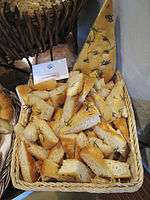 Slices of focaccia al rosmarino
Slices of focaccia al rosmarino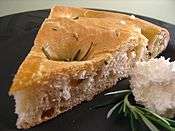 A close-up view of focaccia al rosmarino
A close-up view of focaccia al rosmarino
Similar styles
A very similar style is focaccia alla salvia (focaccia with sage), which is prepared by simply substituting sage for the rosemary.[11] Pizza bianca is another similar style, which is prepared using pizza dough, olive oil, chopped rosemary and salt.[24][25] The term "pizza bianca" refers to focaccia in some areas of Italy.[26]
Potato rosemary focaccia (focaccia con patate e rosmarino in Tuscany) is a variation that is referred to as "potato pizza" in New York City.[27] Pizza is also a similar dish.
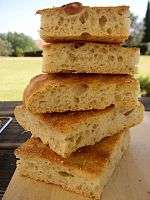 Focaccia con salvia (focaccia with sage)
Focaccia con salvia (focaccia with sage).jpg) Focaccia with rosemary and cheese
Focaccia with rosemary and cheese.jpg) Focaccia with tomato, mozzarella, basil and ham
Focaccia with tomato, mozzarella, basil and ham
See also
Notes
- ↑ "Focaccia with Rosemary; Yield: 1 (12-inch [30cm]) pizza"[7]
- ↑ "What is the main difference between pizza and focaccia? The flattening of the dough, how long you take to roll out the dough, as well as the cooking time. Focaccia sits and rises before being baked. It is only put in the oven when the dough finishes rising. Pizza is placed in the oven immediately." – Gabriele Bonci[8]
References
- 1 2 Panis focacius
- ↑ "A Short History of Focaccia Bread". Big History. WordPress. Retrieved 2012-03-22.
- ↑ Oxford Latin Dictionary (Oxford: Clarendon Press, 1982, 1985 reprinting, p. 718.
- ↑ "History of Focaccia Bread". Abigail's Bakery. Retrieved 2012-03-22.
- ↑ "Focaccia Bread". Retrieved 22 March 2012.
- ↑ http://www.familien-feiern-feste.net/156d763.html
- 1 2 Whitson, C.; Gjesteland, T.; Widen, M.; Hansen, K. (2015). Passion for Pizza: A Journey Through Thick and Thin to Find the Pizza Elite. Agate Publishing, Incorporated. p. pt419. ISBN 978-1-57284-746-0.
- ↑ Whitson, C.; Gjesteland, T.; Widen, M.; Hansen, K. (2015). Passion for Pizza: A Journey Through Thick and Thin to Find the Pizza Elite. Agate Publishing, Incorporated. p. pt73. ISBN 978-1-57284-746-0.
- 1 2 3 4 The Illustrated Step-by-Step Cook. Look & cook. DK Publishing. 2010. pp. 392–393. ISBN 978-0-7566-7507-3.
- 1 2 3 Bertoli, F.B.; Mauriello, F.M.R. (2011). From a Rectory Kitchen. XULON Press. p. 15. ISBN 978-1-61904-695-5.
- 1 2 3 Orsini, G.; Orsini, J.E. (2007). Italian Baking Secrets. St. Martin's Press. p. 113. ISBN 978-0-312-35820-4.
- 1 2 Deseran, S.; Weaver, J. (2013). Picnics: Delicious Recipes for Outdoor Entertaining. Chronicle Books LLC. p. 21. ISBN 978-1-4521-2848-1.
- ↑ "In via Saluzzo un locale consacrato al mollusco". La Stampa (in Italian). November 2, 2015. Retrieved March 4, 2016.
- ↑ Rossi, L.; Verdi, D.; Gialli, G. (2014). Ricette del giorno: Antipasti. Ricette del giorno (in Italian). Bibliotheka Edizioni. p. pt41. ISBN 978-88-98801-59-6.
- 1 2 Klein, D.M. (2001). The Mediterranean Vegan Kitchen: Meat-free, Egg-free, Dairy-free Dishes from the Healthiest Place Under the Sun. HP Books. p. 191. ISBN 978-1-55788-359-9.
- ↑ Marcangelo, J.; Birch, C. (1984). Italian Vegetarian Cooking. Inner Traditions/Bear. p. 94. ISBN 978-0-89281-343-8.
- 1 2 Desert Island Dishes. Infinite Ideas Series. Infinite Ideas. 2012. p. 32. ISBN 978-1-908984-16-6.
- ↑ Sauvage, J. (2015). Gluten-Free Wish List: Sweet and Savory Treats You've Missed the Most. Chronicle Books LLC. p. 59. ISBN 978-1-4521-4389-7.
- ↑ Barnett, A. (1996). Examining Food Technology. Examining Food Technology Series. Pearson Education. p. 44. ISBN 978-0-435-42062-8.
- ↑ Mib, Ftse. "Focaccia al rosmarino e prosciutto". Ticino News (in Italian). Retrieved March 4, 2016.
- ↑ "Spuntini veloci: focaccia con fichi e caprino" (in Italian). Blogo. September 20, 2011. Retrieved 4 March 2016.
- ↑ Bruce-Gardyne, L. (2011). How To Cook for Food Allergies: Understand Ingredients, Adapt Recipes with Confidence and Cook for an Exciting Allergy-Free Diet. Pan Macmillan. p. 186. ISBN 978-1-905744-94-7.
- ↑ Madison, D. (2014). The New Vegetarian Cooking for Everyone. Potter/TenSpeed/Harmony. p. pt391. ISBN 978-1-60774-554-9.
- ↑ Fraioli, J.O. (2009). Pizza & Wine: Authentic Italian Recipes and Wine Pairings. Gibbs Smith, Publisher. p. 81. ISBN 978-1-4236-1250-6.
- ↑ Simonis, D. (2010). Italy. Country Guide Series. Lonely Planet. p. 150. ISBN 978-1-74220-352-2.
- ↑ Riolo, A. (2012). The Mediterranean Diabetes Cookbook. American Diabetes Association. p. 260. ISBN 978-1-58040-483-9.
- ↑ Reinhart, P. (2010). American Pie: My Search for the Perfect Pizza. Potter/TenSpeed/Harmony. p. 235. ISBN 978-1-60774-090-2.
Further reading
| Wikibooks Cookbook has a recipe/module on |
| Wikimedia Commons has media related to Focaccia. |
- Pane, pizze, focacce e torte salate. Voglia di cucinare (in Italian). Giunti Demetra. 2010. p. 229. ISBN 978-88-440-3944-8.

